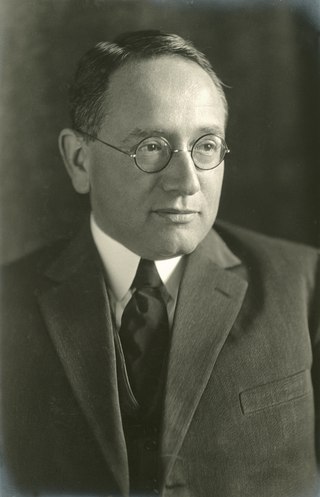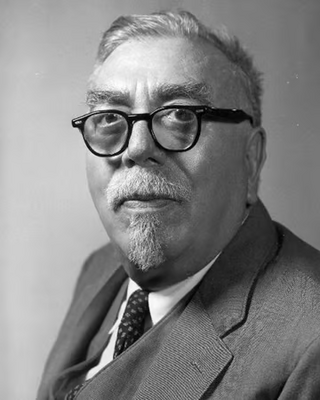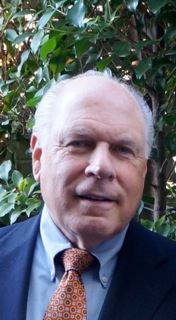
In mathematics, convolution is a mathematical operation on two functions that produces a third function. The term convolution refers to both the result function and to the process of computing it. It is defined as the integral of the product of the two functions after one is reflected about the y-axis and shifted. The integral is evaluated for all values of shift, producing the convolution function. The choice of which function is reflected and shifted before the integral does not change the integral result. Graphically, it expresses how the 'shape' of one function is modified by the other.

George Pólya was a Hungarian-American mathematician. He was a professor of mathematics from 1914 to 1940 at ETH Zürich and from 1940 to 1953 at Stanford University. He made fundamental contributions to combinatorics, number theory, numerical analysis and probability theory. He is also noted for his work in heuristics and mathematics education. He has been described as one of The Martians, an informal category which included one of his most famous students at ETH Zurich, John von Neumann.
Harmonic analysis is a branch of mathematics concerned with investigating the connections between a function and its representation in frequency. The frequency representation is found by using the Fourier transform for functions on the real line or by Fourier series for periodic functions. Generalizing these transforms to other domains is generally called Fourier analysis, although the term is sometimes used interchangeably with harmonic analysis. Harmonic analysis has become a vast subject with applications in areas as diverse as number theory, representation theory, signal processing, quantum mechanics, tidal analysis and neuroscience.

Norbert Wiener was an American computer scientist, mathematician and philosopher. He became a professor of mathematics at the Massachusetts Institute of Technology (MIT). A child prodigy, Wiener later became an early researcher in stochastic and mathematical noise processes, contributing work relevant to electronic engineering, electronic communication, and control systems.

Antoni Zygmund was a Polish mathematician. He worked mostly in the area of mathematical analysis, including especially harmonic analysis, and he is considered one of the greatest analysts of the 20th century. Zygmund was responsible for creating the Chicago school of mathematical analysis together with his doctoral student Alberto Calderón, for which he was awarded the National Medal of Science in 1986.

Elias Menachem Stein was an American mathematician who was a leading figure in the field of harmonic analysis. He was the Albert Baldwin Dod Professor of Mathematics, Emeritus, at Princeton University, where he was a faculty member from 1963 until his death in 2018.

Charles Louis Fefferman is an American mathematician at Princeton University, where he is currently the Herbert E. Jones, Jr. '43 University Professor of Mathematics. He was awarded the Fields Medal in 1978 for his contributions to mathematical analysis.

Terence Chi-Shen Tao is an Australian mathematician who is a professor of mathematics at the University of California, Los Angeles (UCLA), where he holds the James and Carol Collins Chair in the College of Letters and Sciences. His research includes topics in harmonic analysis, partial differential equations, algebraic combinatorics, arithmetic combinatorics, geometric combinatorics, probability theory, compressed sensing and analytic number theory.

Hugh Lowell Montgomery is an American mathematician, working in the fields of analytic number theory and mathematical analysis. As a Marshall scholar, Montgomery earned his Ph.D. from the University of Cambridge. For many years, Montgomery has been teaching at the University of Michigan.

Leon Melvyn Simon, born in 1945, is a Leroy P. Steele Prize and Bôcher Prize-winning mathematician, known for deep contributions to the fields of geometric analysis, geometric measure theory, and partial differential equations. He is currently Professor Emeritus in the Mathematics Department at Stanford University.
Fedor (Fedya) L'vovich Nazarov is a Russian mathematician working in the United States. He has done research in mathematical analysis and its applications, in particular in functional analysis and classical analysis.
Audrey Anne Terras is an American mathematician who works primarily in number theory. Her research has focused on quantum chaos and on various types of zeta functions.

Gilles I. Pisier is a professor of mathematics at the Pierre and Marie Curie University and a distinguished professor and A.G. and M.E. Owen Chair of Mathematics at the Texas A&M University. He is known for his contributions to several fields of mathematics, including functional analysis, probability theory, harmonic analysis, and operator theory. He has also made fundamental contributions to the theory of C*-algebras. Gilles is the younger brother of French actress Marie-France Pisier.

Alfred S. Posamentier is an American educator and a lead commentator on American math and science education, regularly contributing to The New York Times and other news publications. He has created original math and science curricula, emphasized the need for increased math and science funding, promulgated criteria by which to select math and science educators, advocated the importance of involving parents in K-12 math and science education, and provided myriad curricular solutions for teaching critical thinking in math.
Nolan Russell Wallach is a mathematician known for work in the representation theory of reductive algebraic groups. He is the author of the two-volume treatise Real Reductive Groups.

Michael John Dorff is a mathematician at Brigham Young University known for his work in undergraduate research, promoting careers in math, popularizing mathematics, and harmonic mappings.

William Elwood Byerly was an American mathematician. He was the Perkins Professor of Mathematics at Harvard University. He was noted for his excellent teaching and textbooks. Byerly was the first to receive a Ph.D. from Harvard, and Harvard's chair "William Elwood Byerly Professor in Mathematics" is named after him. Byerly Hall in Radcliffe Yard, Radcliffe Institute for Advanced Study, Harvard University is also named for him.

Francis Michael Christ is an American mathematician and professor at University of California, Berkeley, specializing in harmonic analysis, partial differential equations, and several complex variables. He is known for the Christ–Kiselev maximal inequality.
Gregory Beylkin is a Russian–American mathematician.
Lisa Mantini is an American mathematician.














